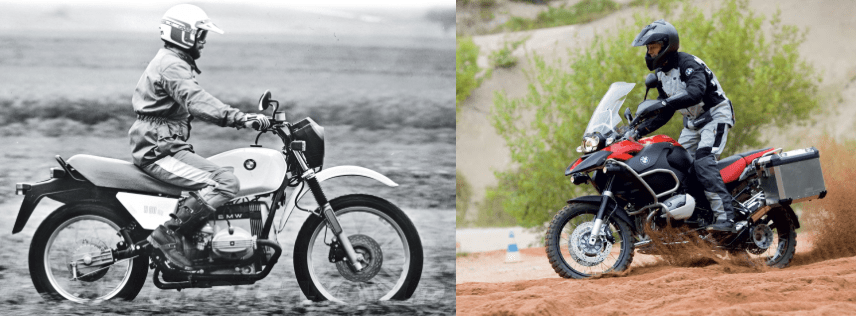As we have reported countless times before, adventure motorcycling is currently enjoying explosive growth. Fueled by Ewen McGregor’s rides around the globe, a motorcycling demographic entering a particular age and financial bracket, or just lucky happenstance, adventure riding is the thing to do. If your motorcycle doesn’t have a set of knobblies, you’ve really missed the boat. At the confluence of rider enthusiasm and manufacturer offerings is the legendary motorcycle that arguably started it all, the BMW GS. This year the entire line of GS bikes sold at a record breaking tempo with roughly 50,000 units leaving dealer floors. BMW’s best selling motorcycle was the new water-pumping R1200GS. There’s no doubt it’s an amazing machine, but does it deliver on the promise of the original GS from three decades ago. What was it then, and what is it now?
The Birth of a Legend
The early years of the GS were filled with answers to questions few people had ever bothered to ask. What happens when an unrelated collection of parts are combined and lobbed into the dirt? A GS is what happens. These were the late 70s and off-road motorcycle racing was gaining in popularity even as it struggled to define itself. BMW recognized the potential, and by the first year of the 80s had introduced a revolutionary steed in the R80GS. At 368 pounds the 797cc air-cooled, flat-twin boxer engine produced 50 hp. It performed exceptionally well, proving itself on the race circuit wherever it went.
While BMW clearly recognized the racing opportunities, they also had the foresight to see this bike had the potential to redefine the touring world. As 1981 came to a close, BMW had sold almost 7,000 of their new GS bikes. To put that in perspective, this year BMW sold 25,000 water-cooled R1200GS motorcycles, and that’s one of the most popular models of all time.
Prior to 1980, most bikes designed for the dirt, even in a split dirt/pavement configuration, were rather small of displacement. A bike with a 797cc engine was at the time, what riders today would dub a “big bike.” With its Monolever, single-sided rear swingarm, it was also presenting revolutionary technology. Throw in a big tank, the ability to haul a considerable amount of gear and a new travel segment was born.
The Evolution of the GS
By the late 80s, the GS had grown up a tad and a new 980cc engine produced an additional 10 hp. Sales were booming and considerable refinements were being made to the driveline and chassis. The Paris-Dakar edition bike of this era was a thing of beauty and was fitted with a colossal 9.25 gallon tank, solo seat, and was in many ways the “Adventure” model of its day.

Without getting too detailed with the evolution of the GS, at least with the bigger variant, it would be safe to say it has undergone a carefully plotted evolution. Refinements have been made consistently to the design of the motorcycle as new technology was made available. It went from being air-cooled to oil-cooled. It was the recipient of BMW’s innovative Telelever front suspension. It was given ABS, traction control, and a host of other technical advancements. As more power and features were added, so too was a considerable amount of heft. By the time the year 2000 rolled around, the big GS tipped 530 pounds. Toss on some luggage and a few farkles, and it was breaking 600 pounds with ease.
By 2005, the engine had been pushed to its current 1200cc displacement. Power had finally reached 100 hp and as is the case with any pinnacle product, the price followed suit. Soaring past the $10,000 and then $15,000 marks, the latest GS bikes are a considerable investment, but then again, they represent the very best of the segment they helped create. Other platforms from other manufactures have challenged the GS as the King of Adventure, but they have all been foiled usurpers of that throne.

This is a big year for the GS as it ushers in a new era with the arrival of the water-cooled R1200GS in “Adventure” trim. It really is a stunner and once again proves BMW is the driving force in adventure riding. With 125 hp on tap, an arsenal of electronic rider aids, a large fuel range, heavy cargo capacity, and off-road chops that can only be described as incredible, the new big bike from Bavaria is a smashing success, and the first unit has yet to be delivered.
Then and Now
When it was first introduced, the R80GS was the proverbial game changer. Nothing like it had existed before, at least not in such a refined final design. They had a clear vision of their target audience and through smart marketing held full reign over that demographic for the entire span of the last three decades. The R80GS may not have seemed large at the time, and maybe it really wasn’t, but it does serve as the era’s then big bike. It was sold with the promise of adventure, and it delivered. By comparison, the R1200GS of today, and certainly the R1200GS-A on the immediate horizon, echo that original directive. Even the pricing has remained relatively constant through the years. That first GS was not cheap. The most recent is going to push well into the twenties with full farkle.

It’s quite refreshing to see a manufacturer maintain such loyalty to an original design for so long. The 2014 GS and GS-Adventure bikes are true descendants of that first R80GS in price, function and spirt. They beg to be loaded with a month’s worth of kit and driven across the horizon. They embody the best of the segment, and symbolize more than just a lifestyle, but a community that transends borders. Over the last 30 years, the GS experience has not changed one iota. It is now precisely what it was then.


